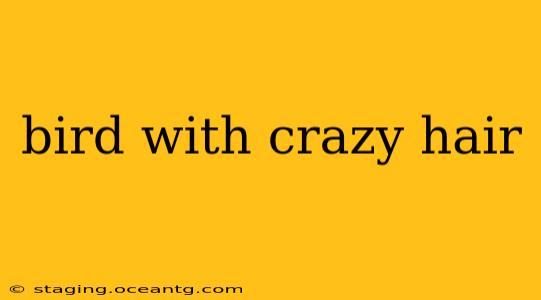The phrase "bird with crazy hair" conjures up images of a feathered friend sporting a truly unconventional hairstyle. While no bird species boasts a deliberately styled "crazy hair" look like humans do, several species exhibit plumage so unique and striking it easily earns them this informal title. This article delves into the fascinating world of avian hairstyles, exploring the reasons behind these unusual appearances and highlighting some of nature's most spectacularly coiffed birds.
What birds have crazy hair?
This is a subjective question, as "crazy hair" is in the eye of the beholder! However, several bird species stand out for their distinctive and often wildly elaborate head feathers. These include, but are not limited to:
-
The Superb Bird-of-Paradise: This species is famous for its incredibly intricate head and breast plumes. Males can erect these feathers into a magnificent, almost helmet-like structure, a truly breathtaking display. The complexity and vibrancy of these plumes are central to their mating rituals.
-
The Long-tailed Widowbird: While not strictly "crazy hair," the elongated tail feathers of the male Long-tailed Widowbird create a visually striking silhouette that some might consider “crazy” in its dramatic proportions. This impressive tail is also crucial for attracting females.
-
Various Species of Hornbills: Several hornbill species possess casque-like structures on their beaks, which vary greatly in size and shape across different species. These structures can appear quite unusual and add to the bird's overall unique appearance. While not feathers, their prominence certainly contributes to a distinctive head profile.
-
The African Crowned Eagle: This majestic bird sports a striking crest of feathers that can be raised or lowered depending on the situation. The crest can give the eagle an almost regal, slightly disheveled look depending on its position.
These are just a few examples. Many other bird species boast unusual crests, tufts, or other head feather arrangements that could be considered "crazy hair" depending on individual perspective.
Why do some birds have such unusual head feathers?
The reasons behind these unusual head feather arrangements are diverse, typically boiling down to three key factors:
-
Sexual Selection: In many species, elaborate head feathers are primarily used in courtship displays. Males with more extravagant plumage are often more successful in attracting mates, leading to the evolution of increasingly elaborate displays over time. The Superb Bird-of-Paradise is a prime example of this.
-
Camouflage & Protection: In some cases, unusual head feathers might serve a protective function. They could help the bird blend into its environment, or they might provide some level of defense against predators. However, this is less common than the role of sexual selection.
-
Species Recognition: Distinct head plumage can also help birds recognize members of their own species, particularly important in dense forests or environments with many similar-looking bird species. This helps them to form pairs and avoid interbreeding.
What causes birds to have different feather colors and shapes?
The vibrant colors and diverse shapes of bird feathers are a result of several factors, including:
-
Pigments: Many feather colors come from pigments within the feather structure itself. These pigments are produced by the bird's body and deposited into the feathers during their growth.
-
Structure: The structure of the feather itself can also affect its color. The way light interacts with the microscopic structures within the feather can create iridescent effects and other striking visual patterns. This structural coloration is responsible for many of the shimmering and metallic colors seen in bird plumage.
-
Diet: The bird's diet can play a significant role in feather color. Certain nutrients are essential for the production of specific pigments. A deficiency in these nutrients can lead to duller or paler feathers.
Are there any health concerns related to unusual feather growth in birds?
While unusual feather growth is often a natural characteristic of a species, it is important to note that abnormal feather growth can sometimes indicate an underlying health problem. In cases where a bird shows unexpected or excessive feather loss, changes in feather structure, or other abnormalities, it is crucial to seek veterinary care to rule out any potential health issues.
In conclusion, the captivating world of birds offers a wide array of fascinating head feather arrangements, often contributing to their unique beauty and playing crucial roles in survival and reproduction. The next time you see a bird with a particularly striking hairstyle, remember the intricate evolutionary processes that have shaped its distinctive look.
